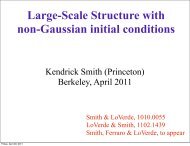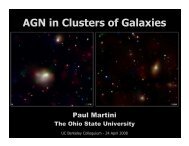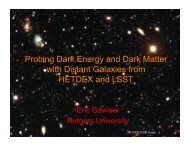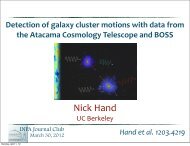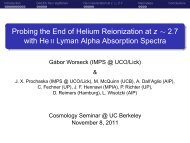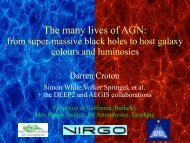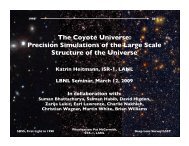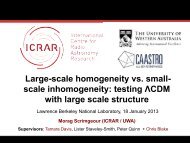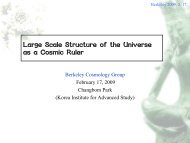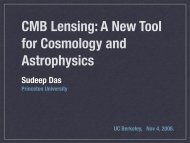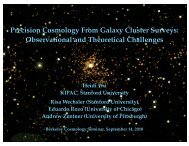The Mean Spectral Energy Distribution and Stellar Mass Density of ...
The Mean Spectral Energy Distribution and Stellar Mass Density of ...
The Mean Spectral Energy Distribution and Stellar Mass Density of ...
You also want an ePaper? Increase the reach of your titles
YUMPU automatically turns print PDFs into web optimized ePapers that Google loves.
<strong>Mass</strong>ive Galaxies, the <strong>Mean</strong> SED, <strong>and</strong><br />
Sept 2006<br />
the <strong>Stellar</strong> <strong>Mass</strong> <strong>Density</strong> at z
Sept 2006<br />
Science Questions<br />
•What is the evolution in the stellar populations <strong>of</strong><br />
galaxies as an ensemble?<br />
•How did stellar mass in galaxies accumulate over time?<br />
•At each redshift, what kind <strong>of</strong> galaxies dominated the<br />
stellar mass density?<br />
Berkeley – Gregory Rudnick
Sept 2006<br />
How do Galaxies Grow?<br />
Berkeley – Gregory Rudnick<br />
•<strong>The</strong> initial conditions are well<br />
known.<br />
•<strong>The</strong> dark matter paradigm is<br />
well developed.<br />
•<strong>The</strong> growth <strong>of</strong> DM halos can be<br />
traced via simulations.
Sept 2006<br />
How do Galaxies Grow?<br />
simulation by volker springel<br />
Berkeley – Gregory Rudnick<br />
•<strong>The</strong> initial conditions are well<br />
known.<br />
•<strong>The</strong> dark matter paradigm is<br />
well developed.<br />
•<strong>The</strong> growth <strong>of</strong> DM halos can be<br />
traced via simulations.
Sept 2006<br />
How do Galaxies Grow?<br />
Berkeley – Gregory Rudnick<br />
•<strong>The</strong> initial conditions are well<br />
known.<br />
•<strong>The</strong> dark matter paradigm is<br />
well developed.<br />
•<strong>The</strong> growth <strong>of</strong> DM halos can be<br />
traced via simulations.<br />
•Add baryonic (gastrophysics)<br />
physics to DM simulation, e.g.:<br />
•star formation, cooling,<br />
feedback from SF, feedback<br />
from an AGN<br />
•From DM to observables!!<br />
•But, physics are very uncertain<br />
<strong>and</strong> observational constraints<br />
are crucial
Sept 2006<br />
Finding high redshift galaxies<br />
•Historically selected in the optical => redshifted rest-frame UV<br />
(e.g. Steidel et al. 1996, Madau et al. 1996)<br />
•UV selected galaxies are relatively unobscured <strong>and</strong> vigorously starforming<br />
Berkeley – Gregory Rudnick<br />
steidel et al.<br />
(2003)
Observing the buildup <strong>of</strong> stellar mass<br />
•One method is to measure the SFR(z)<br />
•Select galaxies in UV <strong>and</strong> convert UV light to SFR<br />
•assume IMF + dust<br />
•Dust extinction is important, but uncertain<br />
•Misses contribution from heavily obscured galaxies, e.g. Sub-mm<br />
galaxies<br />
Sept 2006<br />
Berkeley – Gregory Rudnick<br />
Giavalisco et al. 2004
Sept 2006<br />
An Alternative: Tracing the<br />
<strong>Stellar</strong> <strong>Mass</strong> Build-up Directly<br />
•Need observations in rest-frame optical/NIR<br />
•Measures “older” light<br />
•More sensitive to lower mass stars<br />
•less IMF dependence<br />
•Less affected by extinction<br />
•Must observe in near-IR/MIR<br />
Berkeley – Gregory Rudnick
Sept 2006<br />
What have deep NIR surveys<br />
told us about the galaxy<br />
population at high redshift?<br />
Berkeley – Gregory Rudnick
Sept 2006<br />
NIR selected Distant Red Galaxies<br />
(DRGs)<br />
Franx et al. (2003)<br />
Discovered by Faint InfraRed<br />
Extragalactic Survey (FIRES)<br />
GR<br />
Ivo Labbè, OCIW, Pasadena<br />
Natascha Förster Schreiber, MPE, Garching<br />
Marijn Franx, Leiden<br />
Pieter van Dokkum, Yale<br />
Hans-Walter Rix, Heidelberg<br />
•Lyman Break Galaxies don’t<br />
have colors <strong>of</strong> normal galaxies<br />
•DRGs have colors <strong>of</strong> local<br />
galaxies <strong>and</strong> have large restframe<br />
optical breaks<br />
Förster Schreiber et al. (2004)<br />
Berkeley – Gregory Rudnick
<strong>The</strong> most common massive galaxy at 2
Sept 2006<br />
Detailed Characteristics<br />
Labbé et al. (2005)<br />
Berkeley – Gregory Rudnick<br />
• More massive <strong>and</strong> older<br />
than UV-selected galaxies<br />
• Some are consistent<br />
with being quiescent<br />
•confirmed by NIR<br />
spectroscopy<br />
(Kriek et al. 2006)
Queiscent <strong>Mass</strong>ive Galaxies<br />
Sept 2006<br />
Berkeley – Gregory Rudnick<br />
9 out <strong>of</strong> 20 K
<strong>Mass</strong>ive Star Forming Galaxies<br />
Webb et al. (2006)<br />
Knudsen et al. (2005)<br />
Sept 2006<br />
Many DRGs have a high SFR<br />
Sept 2006<br />
Field-to-field Variance<br />
HDF-N<br />
HDF-S<br />
Cosmic variance in this population<br />
is large.<br />
Berkeley – Gregory Rudnick<br />
• GOODS-S is underdense bv<br />
~2 in number <strong>of</strong> massive z~2<br />
galaxies<br />
Multiple fields needed to measure<br />
their contribution to the mass<br />
density.<br />
Labbé et al. (2003)
Sept 2006<br />
Clustering<br />
Measured over 300 square arcminutes from MUSYC survey<br />
DRGs are strongly clustered (Quadri et al. 2006)<br />
Berkeley – Gregory Rudnick
How to address Science Questions<br />
•A comprehensive census <strong>of</strong> all stars<br />
Sept 2006<br />
•color selection is biased<br />
•Control field-to-field variance<br />
•Emphasize consistent comparison to theory<br />
Berkeley – Gregory Rudnick
Sept 2006<br />
Redshift bins Rudnick et al. ApJ, in press<br />
L V limit<br />
Berkeley – Gregory Rudnick<br />
astro-ph/0606536<br />
4 fields with deep<br />
Optical/NIR data<br />
HDF-S<br />
MS1054-03<br />
GOODS-S<br />
HDF-N<br />
Calculate luminosity<br />
density in complete<br />
region
Sept 2006<br />
Volume Averaged rest-frame<br />
SED <strong>of</strong> Luminous Galaxies<br />
z=0.1<br />
Berkeley – Gregory Rudnick<br />
Color <strong>of</strong> the Universe is<br />
consistent with<br />
morphologically normal<br />
nearby galaxies
non-<br />
DRGs<br />
DRGs<br />
Sept 2006<br />
Volume Averaged rest-frame<br />
SED <strong>of</strong> Luminous Galaxies<br />
z=0.1<br />
z=2.01<br />
z=2.8<br />
Berkeley – Gregory Rudnick<br />
Color <strong>of</strong> the Universe is<br />
consistent with<br />
morphologically normal<br />
nearby galaxies<br />
Split by J-K color<br />
DRGs are redder at all<br />
wavelengths
Sept 2006<br />
<strong>The</strong> benefits <strong>of</strong> averaging<br />
Berkeley – Gregory Rudnick
Sept 2006<br />
Evolution in 〈M/L V 〉<br />
Berkeley – Gregory Rudnick<br />
〈M/L V 〉 declines by a<br />
factor <strong>of</strong> ~10<br />
DRGs have higher<br />
M/L than non-DRGs
Sept 2006<br />
Observed ρ * Evolution<br />
Berkeley – Gregory Rudnick<br />
density increase by<br />
factor <strong>of</strong> ~4-10 from<br />
z=3 to 0<br />
Still large field-to-field<br />
variations<br />
rough agreement with<br />
integral <strong>of</strong> SFR(z) (from<br />
UV)
Sept 2006<br />
Comparison with Models<br />
Finlator et al. 2006<br />
Croton et al. 2006<br />
Berkeley – Gregory Rudnick<br />
DRGs contribute<br />
significantly to stellar<br />
mass budget at 1.6
Sept 2006<br />
Conclusions<br />
• Volume averaged SED evolves monotonically to redder<br />
colors from z = 3 to 0.<br />
• <strong>Mean</strong> SED at all redshifts is consistent with<br />
morphologically normal local galaxies.<br />
•Total mass density increases by ~4-10 from z = 3 to 0<br />
• UV-selected samples miss ~50% <strong>of</strong> mass in luminous<br />
galaxies<br />
• Consistently compared models fail to match<br />
observations.<br />
Berkeley – Gregory Rudnick




